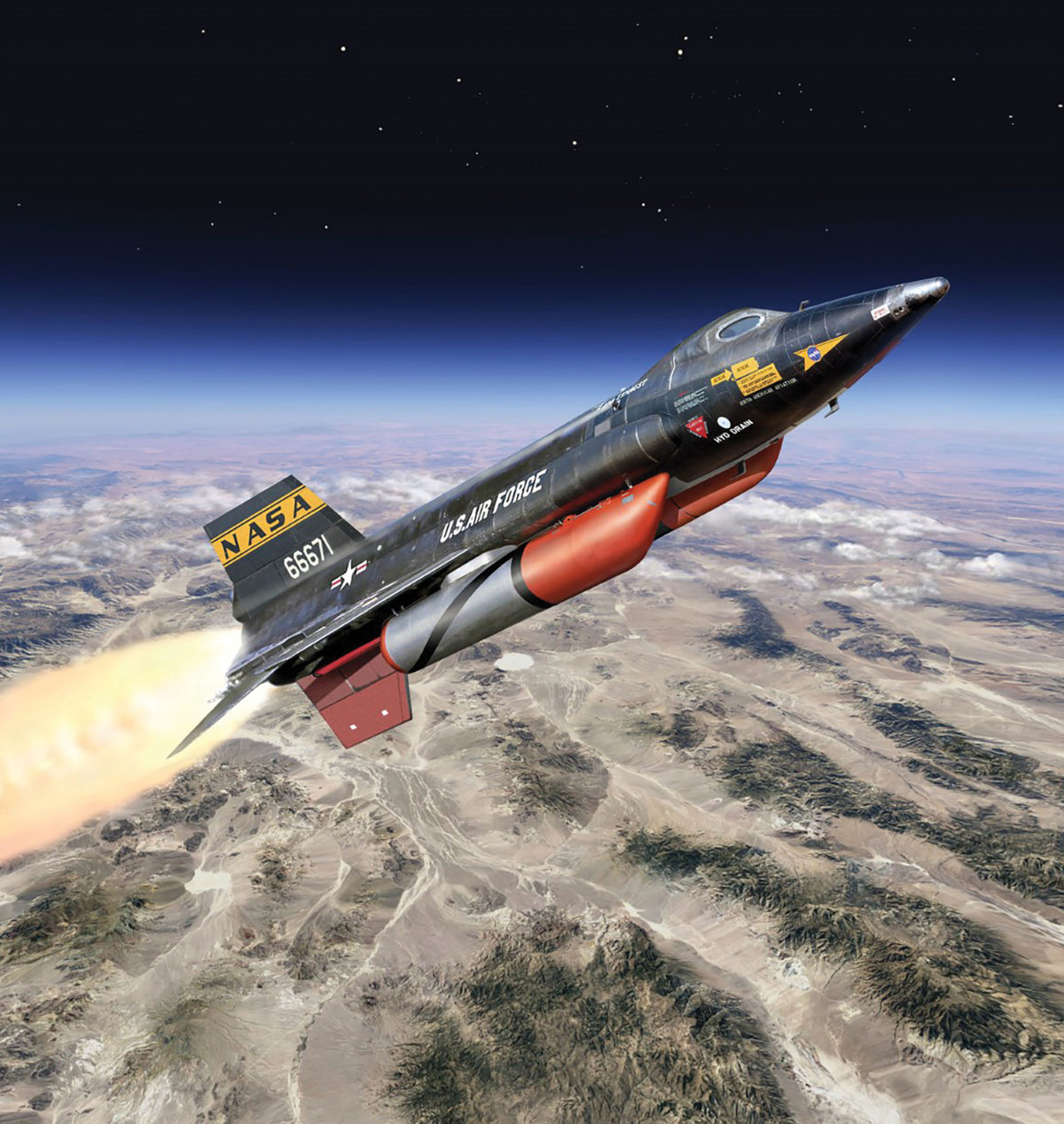By late 1962, North American Aviation’s three X-15s seemingly had done it all. They had flown past Mach 6 and nearly 60 miles high, launching from two modified Boeing B-52s and propelled by 57,000-pound-thrust rocket engines burning nearly nine tons of anhydrous ammonia and liquid oxygen in less than 90 seconds. Their pilots held the Harmon and Collier trophies, and America’s charismatic young president, John F. Kennedy, hailed their heroism. They had their own motion picture, X-15, featuring Charles Bronson, Mary Tyler Moore and the twangy narration of ex–B-24 combat commander Jimmy Stewart.
But when the second X-15 launched on the morning of November 9, 1962, for a Mach 5-plus stability investigation, the rocket plane’s Thiokol LR99 engine sputtered at just 30 percent thrust, forcing NASA Flight Research Center pilot Jack McKay to make an emergency landing on the baked clay of Nevada’s Mud Lake. As it glided earthward, the X-15 still retained some residual propellants. Then its flaps wouldn’t deflect. Sinking fast, it slammed down at more than 290 mph. A strong down-load imposed by its deflected horizontal stabilizer did the rest.
Investigators reported: “The left main-gear strut collapsed; the ventral fin struck the ground and was torn to bits; the left stabilizer dug into the ground and was torn off; the nose-wheels failed at the hubs; the airplane skidded for about 1,400-ft on the left-wing tip, the right main-gear skid, and the nose-wheel strut; the airplane gradually turned toward the left, and finally turned over when the right wing tip dug into the ground.”

McKay was trapped in a smoking, rumbling hulk leaking propellants and venting gases. As a twin-rotor Piasecki H-21B helicopter blew ammonia fumes away from the cockpit, rescuers ignored the risks and freed McKay who, though suffering a cracked vertebra, recovered to fly again.
So, too, did the second X-15. North American suggested, and the U.S. Air Force agreed, to rebuild it as a faster, more capable aircraft. It returned to Edwards Air Force Base in mid-February 1964 with numerous changes and a new designation: X-15A-2. It had jettisonable external tanks, one for liquid oxygen and the other for anhydrous ammonia, boosting engine burn-time to more than 141 seconds, sufficient to exceed Mach 7. A stub pylon for a scramjet (supersonic combustion ramjet) could replace its ventral fin, and the fuselage had a plug for liquid hydrogen tanks to fuel it. A helium tank for propellant pressurization nestled behind the vertical fin. Extended fairings held additional hydrogen peroxide for two auxiliary power units (APUs). Its landing gear was stronger and longer. The canopy had heat-resistant three-layer elliptical windshields, replacing crack-prone two-layer trapezoidal ones. An experiments bay was situated behind the cockpit. The outer right wing could be replaced for structure and materials studies. Finally, it had strengthened launch shackles to carry the extra weight of its jettisonable tanks and added structure.
On June 25, 1964, Lt. Col. Robert A. Rushworth piloted the X-15A-2 on its first flight. Four flights followed—one by McKay and three by Rushworth, each with a disturbing landing gear incident. First, the nose gear extended at Mach 4.3; then a gear door scoop opened at Mach 4.5; and finally the right landing skid extended at Mach 4.3. “Boy,” Rushworth fumed after the last incident, “I’ve had enough of this!” All reflected uneven thermal expansion, forcing changes to up-locks and actuator cables. Rushworth then moved on, succeeded by a new pilot, 35-year-old USAF Major William J. “Pete” Knight.
Slight in stature, Knight was a towering presence at Edwards. He had been commissioned in 1953 after enlisting during the Korean War, and won the Allison Jet Trophy Race the following year. Awarded a degree in aeronautical engineering from the Air Force Institute of Technology in 1958, he then attended the prestigious Test Pilot School at the Air Force Flight Test Center (AFFTC), graduating in April 1959.
Knight was assigned to Edwards’ legendary Test Ops, flying the early “Century Series” fighters and other aircraft. In 1960 he flew chase for Scott Crossfield during the X-15’s proving flights. Then the USAF picked him to pilot Boeing’s X-20 Dyna-Soar orbital boost-glider. After Secretary of Defense Robert McNamara canceled the project on December 10, 1963—an infamous decision Knight neither forgot nor forgave—he returned to the AFFTC for spaceflight training.
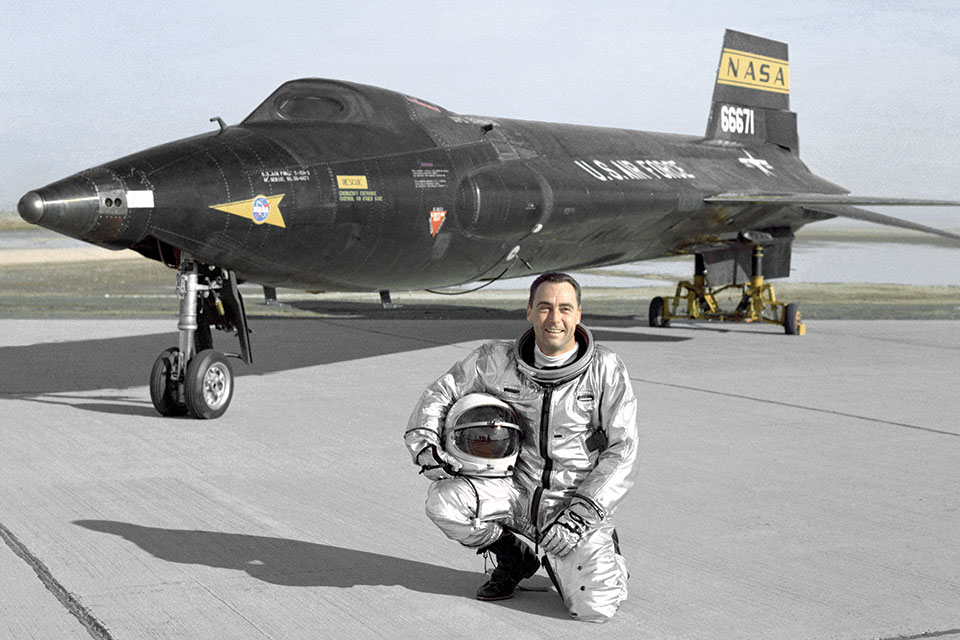
Knight checked out in the first X-15 on September 30, 1965, reaching Mach 4.06 at 76,600 feet. He did not pilot the X-15A-2 until the summer of 1966, when he made three flights carrying a star-tracking experiment, peaking at 249,000 feet.
Afterward, the X-15A-2 team focused on trying to reach and even exceed Mach 7. Their first task was to test-jettison the external tanks and continue on internal propellants, which Knight did on November 18, 1966. Launching near Mud Lake, he dropped the tanks at Mach 2.27 and 69,700 feet and raced to Mach 6.33 (4,261 mph) at 98,900 feet. “When those tanks go, it is the loudest bang and jolt I have had in a long time,” he reported. “It sounded like the whole airplane blew up.”
The second task was checking flight behavior with a dummy scramjet on the pylon, which Knight performed on May 8, 1967, launching over Hidden Hills dry lake and hitting Mach 4.75 at 97,600 feet.
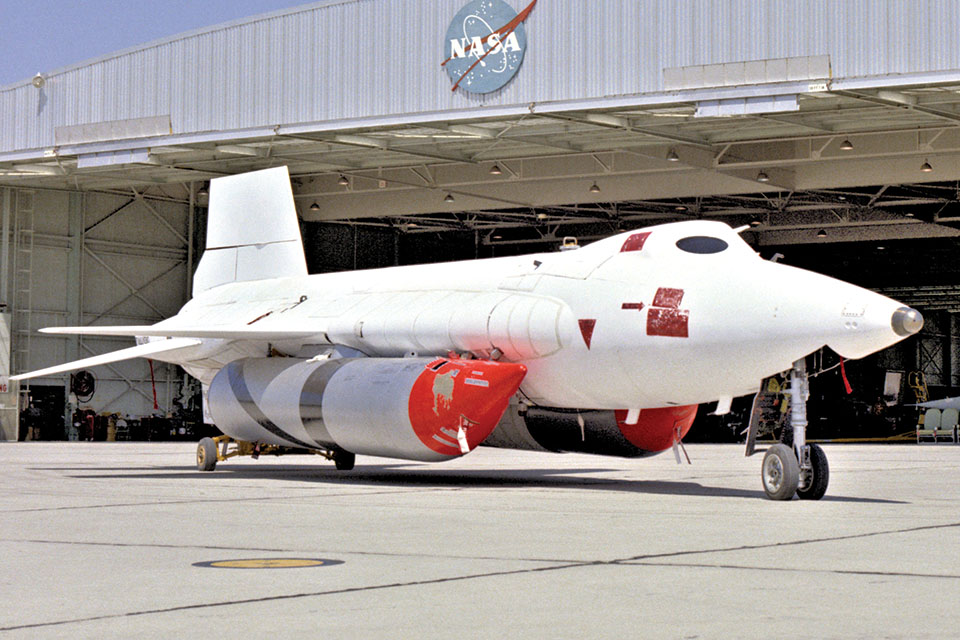
Third was readying the X-15A-2 to survive higher temperatures than its original 1,200-degree limit. NASA planned to spray MA-25S, a Martin-developed silicone-based ablative coating, over the underlying Inconel-X nickel-alloy structure and fit pre-formed ablative strips around the leading edges of the wings, tail surfaces and windscreen. The X-15A-2 could then test what might be an easy method for protecting future spacecraft on reentry.
In May and June 1967, technicians applied the dull flamingo-pink ablator and fitted the strips. After the coating cured, they applied white sealer for safety, since MA-25S, exposed to liquid oxygen, detonates if struck with an 8-pound force! Program leaders well remembered how, just a decade earlier, Bell, the USAF and NASA-predecessor NACA had lost three airmen killed or injured, four rocket planes blown up and two mother ships wrecked by explosions caused by lox-chilled leather gaskets that detonated when jolted, and wanted to avoid any repeat.
Engineers prevented MA-25S residue from obscuring pilot vision via a Solomonic solution: Since X-15s typically flew left-hand landing patterns, they installed an “eyelid” over the cockpit canopy’s left pane. During hypersonic speed runs, ablating MA-25S would render the right pane opaque, but as Knight neared Edwards he could open the eyelid and fly his approach and landing looking out the clear left pane.

On June 29, 1967, while the X-15A-2 received its coatings, Knight flew the first X-15—and it nearly killed him. He was climbing through 104,000 feet at Mach 4.17 and “really enjoying the flight” when an electrical arc from an onboard experiment dumped both APUs, causing the LR99 to quit. Knight radioed a terse “Shutdown” as warning lights flashed on, then off, and the twin APUs wound down, taking away all electrical and hydraulic power. He tried the mechanical reaction controls, but found them ineffective. Without instruments, communications or controls, Knight was a passenger in an ascending ballistic missile.
The X-15-1 peaked at 173,000 feet. Going over the top he looked right, seeing Mono Lake, “clear and beautiful.” Left was Mud, Knight thinking (as he told me in 1982), “Take a good look, Pete—that’s probably where you’ll plant it.” Momentarily he considered ejecting in the lower atmosphere. But, as the X-15 descended, he flipped on its emergency battery. The right APU refused to start, but the left did, restoring most controls and some instruments, but not his radio or angle-of-attack (AOA) indicator, both critical for reentry.
Reflexively, Knight pulled the nose up until the X-15 began to yaw, immediately easing off, and then pulled to yaw again. It was risky but it worked and the X-15 leveled at 45,000 feet. He then rolled into a sustained 6G left turn, setting up an approach to Mud Lake, and made a no-flap landing. unscathed, save for a bad head bump exiting the airplane, Knight received the Distinguished Flying Cross for his steady nerve and great skill.
The X-15A-2 was ready by late summer, pristine in its new all-white finish. Previous flights had evaluated MA-25S on panels and surfaces, but never as an entire coating. Knight did so on August 21, 1967, launching over Hidden Hills and flying out to Mach 4.94 at 91,000 feet. Decelerating through Mach 2.5, he opened the eyelid, which acted as a tiny canard, inducing a mild coupled pitch-roll-yaw. He jettisoned the dummy scramjet and landed.
Engineers found the MA-25S generally in “very good condition,” but the stub ventral fin had suffered severe erosion to its leading edge, the significance of this missed despite engineers recognizing that “shock waves originating from the dummy ramjet shape” had caused it. Technicians added a high-temperature probe at the forward apex of the vertical fin, made APU and propellant checks, and refurbished the ejection seat.
The team mated the X-15A-2 to the NB-52B mother ship on September 25, anticipating flying later that week. But rains rendered Mud Lake a reality, so the date slipped to the first week of October. The test plan stipulated 6,500 feet per second (Mach 6.57) at 100,000 feet, faster than any previous manned winged flight.
At 1:30 p.m. on October 3, 1967, following a 90-minute hold for a leaky jettison valve and a faulty helmet, the NB-52B, piloted by Colonel Joseph Cotton and Major William Reschke, took off with Pete Knight and the X-15A-2 snugged under its right wing. Four chase planes went up as well: three F-104s and a T-38. A C-130 with paramedics and a rescue vehicle orbited on-call near Grapevine Dry Lake. NASA and the AFFTC pre-placed fire trucks and comm vehicles on Mud, Cuddeback and Rogers dry lakes, together with two helicopters, a UH-1 at Mud and an H-21 at Rogers.
The climb-out passed smoothly save for glitches with a yaw check and missed radio calls. At 2:32 p.m., the NB-52B was at 43,750 feet a dozen miles east-northeast of Mud Lake. Launch panel operator Jack Russell radioed “3-2-1-launch,” and Knight hit the launch switch. Briefly, the X-15A-2 remained in place until he hit it again. Thereafter, he reported, “It was one of the smoothest launches I have had.”
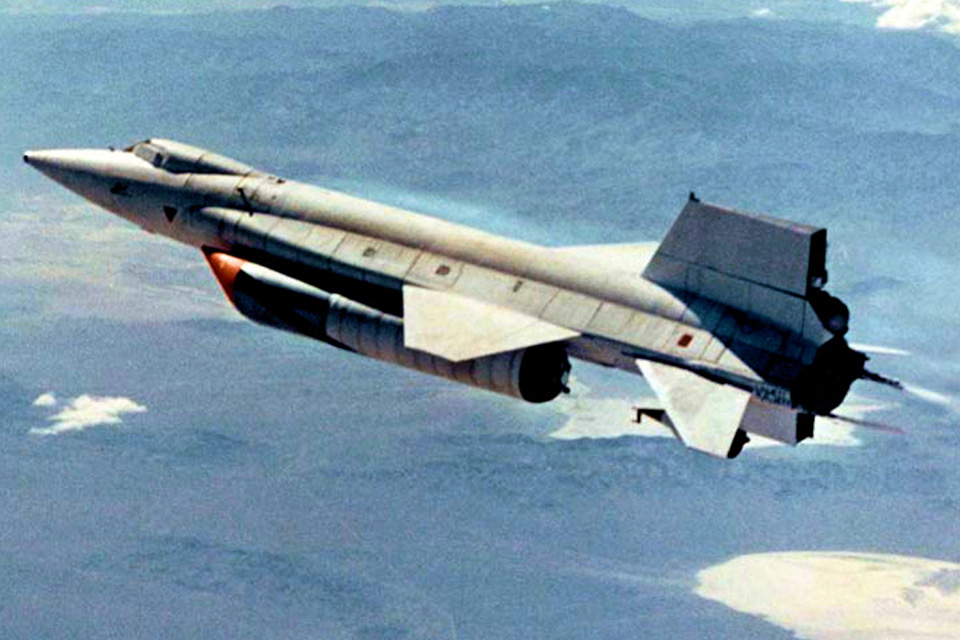
Knight compensated for a left rolling tendency from the external tanks’ differing weights, transitioned into the 35-degree climb-out (holding a +2-degree AOA) and jettisoned the tanks at Mach 2.2 and 73,500 feet just over a minute into the flight, pressing on into the upper stratosphere.
He leveled at 100,000 feet, increasing the AOA to +6 degrees to maintain a zero rate of climb. Pitch control was “very sensitive,” with the AOA bobbing between +4 and +7 degrees. When his inertial speed indicator read 6,500 fps, he shut down the LR99 after a 141.4-second burn. In fact, the X-15A-2 had flown significantly faster, as the inertial indicator—like all inertial systems—was subject to lag. More precise data from the X-15 program’s radar tracking station at Beatty, Nev., revealed it had actually attained 6,630 fps, Mach 6.7 (4,520 mph), at 102,100 feet—a speed record for manned aircraft that stands to this day.
Though the MA-25S generally protected the underlying Inconel-X structure, it also prevented it from absorbing and radiating the heat its designers had anticipated, creating local hotspots. Intersecting shockwaves from the scramjet and pylon had created roiling turbulent flows generating temperatures exceeding 2,800 degrees. The ablator rapidly eroded, portions of the dummy scramjet melted and the pylon burned through, feeding searing flow into the aft end.
At its higher velocity, the X-15A-2 flew a higher deceleration profile than planned, resulting in NASA mission controller (and X-15 pilot) Bill Dana twice warning Knight he was “high on energy” and had to “trim down.” Knight, “pretty well relaxed by this time,” performed stability and control maneuvers during which the ball nose sensor briefly stuck, preventing measurement of yaw response, possibly because of heating. Over Cuddeback at 80,000 feet and Mach 4, a hydrogen peroxide overheat light came on, triggered by the superheated air in the aft end, and Dana radioed, “Go jettison on the peroxide, Pete.” Finally, a heat-weakened line and a malfunctioning valve vented all the helium for expelling residual propellants. Knight, like McKay, thus had to land approximately 1,500 pounds heavy.
Turning slightly right from his arrow-like launch track, Knight passed five miles east of Edwards’ North Base at 55,000 feet and Mach 2.2, opening the eyelid and beginning a left turn at Mach 1.7 that took him over the south lake at 44,000 feet. As he curved through the turn, the partially melted scramjet separated at Mach 1.02 and 32,000 feet, appropriately falling like a bomb into the Edwards bombing range. Now down to 20,000 feet, Knight wisely rejected landing on lakebed Runway 23, opting for more distant Runway 18, where he made “a very smooth touchdown” at 2:40, eight minutes after launch.
Per procedure, after coming to a halt, Knight recorded his final instrumentation readings, wondering why his ground team was looking toward the airplane and not helping him out. The answer became clear when he saw the blackened back end.
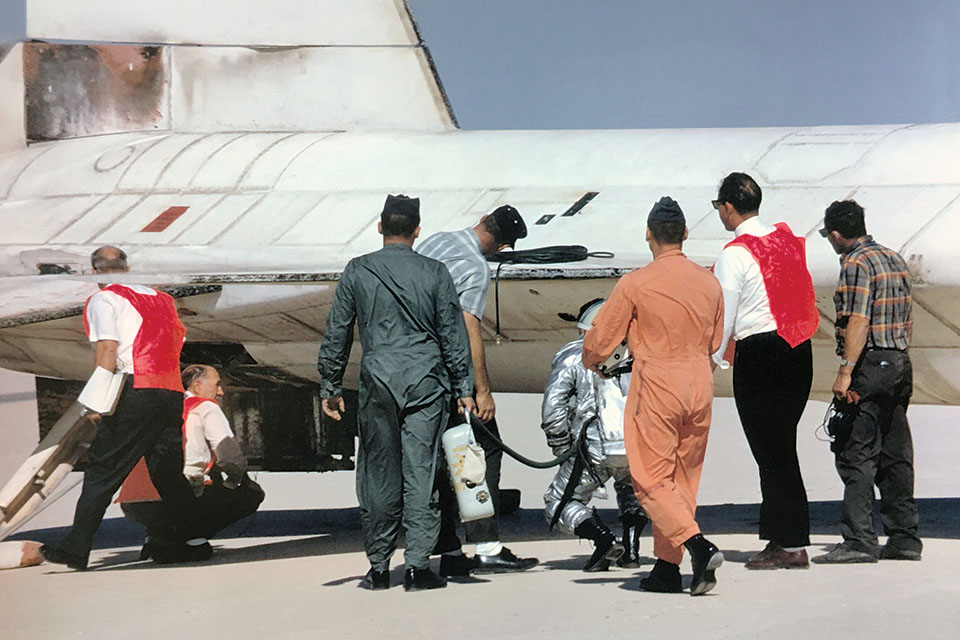
The damage stunned NASA engineers. The Flight Research Center’s Jack Kolf told me in 1977, “If there had been any question that the airplane was going to come back in that shape, we never would have flown it.” FRC thermodynamicist Joe Watts saw the flight’s major lesson as teaching engineers to take “extreme care in the design of hypersonic vehicles where shock impingement and interference effects are present because of the extremely high temperatures encountered.” NASA’s John Becker—father of the X-15—agreed, urging future designers to pay “maximum attention to aerothermodynamic detail in design and pre-flight testing.”
Afterward, NASA generally cooled to both refurbishable ablators for cheap hypersonic protection and hypersonic pylon-mounted engines. The latter reflected the phenomenally destructive power of colliding shockwaves revealed by the X-15A-2. Two conical oblique shockwaves from the scramjet had impinged on a bow shockwave formed by the pylon, generating superheated high-pressure vortices that scoured off the MA-25S ablator, wrinkled the fuselage at the pylon’s base, burnt through the pylon itself and melted portions of the scramjet. Three of four explosive bolts holding the scramjet in place had detonated, weakening the fourth so it fractured, causing the scramjet to fall off the airplane.
Though North American returned the X-15A-2 to readiness, it never flew again. Today it is displayed in bare Inconel-X finish at the National Museum of the U.S. Air Force in Dayton, Ohio. The NB-52B that carried it is exhibited outside Edwards’ North Gate.
As for Pete Knight, on October 17, he flew the third X-15 to 280,500 feet (53.13 miles), earning astronaut wings. (Sadly, on November 15, that X-15 crashed, killing Major Mike Adams.) He and Bill Dana closed out the program the following year. Knight flew the first X-15 three more times, and would have on December 20, 1968—planned as the 200th flight—but Edwards had snow! The team demated the first X-15 and NB-52B, ending an era.
The Mach 6.7 flight earned Knight the Harmon Trophy for 1967 (and the nickname “Speedy Pete”), presented by President Lyndon B. Johnson in a Cabinet Room ceremony on December 3, 1968. Johnson noted “his workday is spent on the fringes of space” and “his bravery and his skill have been tested time and again.”
Both were soon tested again. Like X-15 pilots Bob White and Bob Rushworth, Knight left the High Desert for Vietnam, flying 253 combat missions in F-100Ds. In 1982 he told me (while shaking his head), “Nothing is as scary as bombing and strafing at night under flares.” Afterward, he rose steadily through Air Force Systems Command, finishing his career as vice commander of the AFFTC, as the Air Force entered the era of the A-10, B-1, F-15 and F-16, all of which he flew.
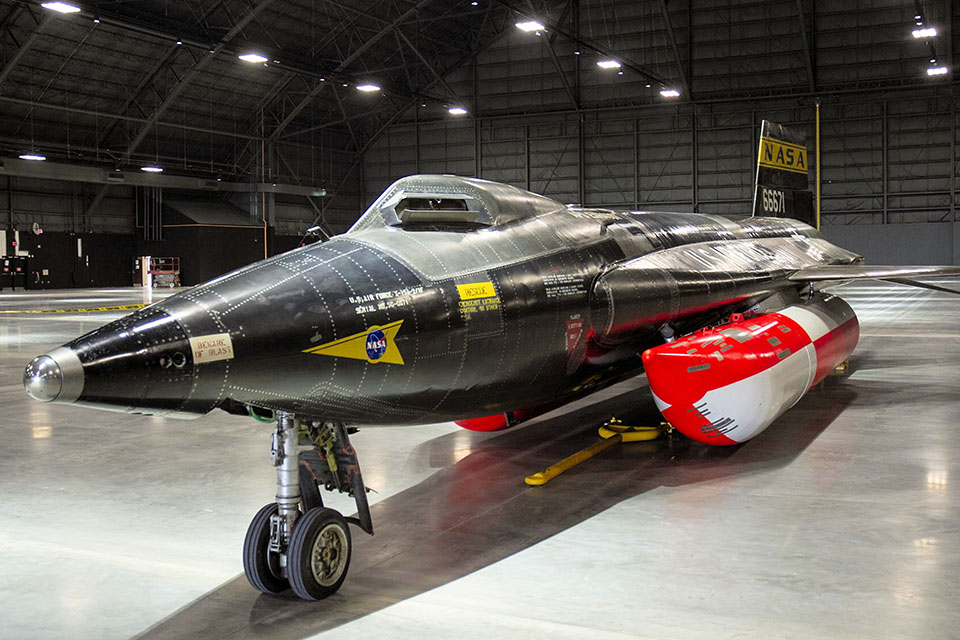
Richly honored, Knight held the Legion of Merit with one Oak Leaf Cluster, Distinguished Flying Cross with two Oak Leaf Clusters, Air Medal with 10 Oak Leaf Clusters, Octave Chanute Award and an Air Force Association Citation of Honor in addition to the Harmon Trophy. He retired in 1982, memorably proclaiming at his Edwards officers’ club farewell banquet: “People say, ‘It’s time to go’ and ‘We all have to make way for young people.’ Well, I say, ‘To hell with them!’” The room erupted in laughter and applause.
Never one to remain idle, he entered politics, serving as mayor of Palmdale, Calif., then in the California Assembly and Senate, his license plate emblazoned with “X-15A-2.” He became president of The Society of Experimental Test Pilots, and was inducted into the National Aviation Hall of Fame, California’s Aerospace Walk of Honor and New Mexico’s International Space Hall of Fame.
Active to the end, Pete Knight died in 2004 at age 74, justly hailed as one of the world’s greatest aerospace pioneers. But for all his many accomplishments, it is as an airman’s airman that he is best remembered—his flight to Mach 6.7 the highlight of both an extraordinary program and a celebrated career.
Aerospace historian and analyst Richard P. Hallion was a founding curator of the National Air and Space Museum, wrote the official history of the NASA Flight Research Center and subsequently served as Air Force Flight Test Center historian and oversaw the Air Force History and Museums Program. For further reading, he recommends: The X-15 Rocket Plane: Flying the First Wings Into Space, by Michelle L. Evans; X-15: Extending the Frontiers of Flight, by Dennis R. Jenkins; and At the Edge of Space: The X-15 Flight Program, by Milton O. Thompson.

